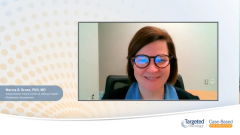
Patient Profile: A 43-Year-Old Man with RAI-R-DTC
Marcia S. Brose, MD, PhD, presents the case of a 43-year-old man with radioiodine-refractory differentiated thyroid cancer (RAI-R-DTC) and offers her initial impressions.
Episodes in this series

Case: A 43-Year-Old Man with RAI-R-DTC
Initial presentation and initial treatment:
- A 43-year-old man presents with fatigue, neck pain and dysphagia and was diagnosed with papillary thyroid carcinoma 10 years ago
- Following a total thyroidectomy, he underwent multiple rounds of radioactive ablation therapy.
- Initial response was positive with undetectable thyroid globulin levels and negative imaging
- PMH: Hyperlipidemia; Hypertension; Diabetes (controlled with medications)
- SH: lives with his wife and 2 teenage children; non-smoker and drinks alcohol occasionally
- PE: appears fatigued with a palpable thyroid nodule in the left lobe
- Neck examination: palpable mass in the left neck, and cervical lymphadenopathy
Clinical workup
- Labs: WNL
- Neck ultrasound: Identifies a large, irregular mass in the left thyroid bed with invasion into surrounding structures.
- CT of the neck and chest revealed neck mass along with multiple pulmonary nodules, largest 2cm x 1.5cm
- TSH: Within normal limits
- Thyroglobulin levels: Markedly elevated
- Radioactive iodine scan: Confirms radioiodine refractory disease with widespread involvement of cervical lymph nodes and distant metastases.
- Needle biopsy was performed which confirmed Papillary thyroid cancer. Next-generation sequencing was negative for mutations, rearrangements
Subsequent treatment and follow-up
- Lenvatinib 24mg po qd was initiated
This is a video synopsis/summary of a Case-Based Peer Perspectives featuring Marcia S. Brose, MD, PhD.
Brose presents a case of a 43-year-old man diagnosed with papillary thyroid cancer 10 years prior. The patient had undergone a total thyroidectomy and multiple rounds of radioactive iodine therapy. He presented with fatigue, neck pain, difficulty swallowing, and a palpable mass in the left neck. Imaging revealed a neck mass invading surrounding structures and multiple pulmonary nodules. A radioactive iodine uptake scan confirmed disease refractory to radioactive iodine. Next-generation sequencing was negative for mutations and rearrangements. The patient started on lenvatinib at 24 mg.
Brose discusses the appropriateness of lenvatinib treatment, noting its superior response rate and progression-free survival rate when compared with sorafenib, as demonstrated in a phase 2 head-to-head study. She also emphasizes the importance of starting lenvatinib at the full 24 mg dose, as supported by dose-finding studies showing improved outcomes without increased grade 3 adverse events or detriment to overall functioning.
Video synopsis is AI-generated and reviewed by Targeted Oncology™ editorial staff.










































